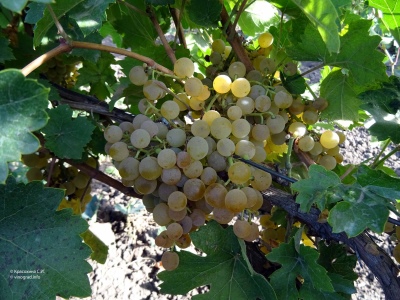
- Authors: Central Asian experimental station VIR, in "Vierul", Moldova
- Appointment: dining room
- Berry color: greenish amber
- Taste: harmonious, nutmeg
- With bones: Yes
- Ripening period, days: 107-115
- Frost resistance, ° C: -20
- Bunch weight, g: 340
- Yield: 82-120 c / ha
- Flower type: bisexual
The Muscat Amber grape variety is in good demand among gardeners and winegrowers. It produces pleasant, tart white wines. When eaten fresh, the berries are not inferior in taste to other varieties.
Breeding history
The Muscat Yantarny grape variety was bred in the Moldavian Research Institute of Life Sciences of NPO Vierul together with the Central Asian Experimental Station VIR. The authors of the variety were Zhuravel M.S., Borzikov G.M., Gavrilov I.P., Frolov A.I. The variety is included in the state register in the Kabardino-Balkarian Republic, Krasnodar Territory and in the Republic of Adygea.
Geography of distribution
Recommended growing regions for the Muscat Yantarny variety are the Crimean Peninsula, the Republic of Adygea, Kabardino-Balkaria and the Krasnodar Territory.
Description
The Muscat Amber grape is a table variety. Designed more often for the production of tinctures and wines. The plant is medium-sized. Leaves are medium in size, rounded. The bush contains 90% of fruitful shoots. The number of inflorescences on the shoots is 0.7-1.8. Annual shoots are light brown in color. The flowers of Muscat Amber are bisexual.
Ripening period
The grape variety belongs to the early ripening period. The harvest ripens in 107-115 days.
Bunches
The shape of the bunch is cylindrical-conical, has an average density. The leg is short, its length is 4 cm. The weight of one bunch is 340 g.
Berries
Berries are greenish-amber in color, there are small bones - 2-3 pcs. seeds in one berry. Fruits are medium in size - 19x17 mm, round in shape, dense skin. The consistency of the pulp is fleshy and juicy. Sugar content 220-250 g / dm3, acidity 16-18 g / dm3. The berries are highly transportable.
Taste
The grape has a harmonious, nutmeg flavor. Consumer tasting score - 8.4-9 points.
Yield
The grape variety has a high yield - 82-120 kg / ha. Harvesting is done in August.


Growing features
Amber Muscat is planted in well-lit areas. For the variety, only a warm, sunny climate is preferable. The soil for planting should be rich in minerals and vitamins, as well as easily permeable to oxygen.
Landing
When planting grapes, it is necessary to take into account the distance between the rows of 2.5 m and the bushes - 2 m. Before planting the plant, it is imperative to apply mineral fertilizers and ash. Before planting, the seedling must be soaked for 1-2 days in a solution with a growth stimulator. And also for good growth of the bushes, the grapes are tied up, or trellises are installed.

Pollination
The type of pollination of the variety is bisexual.
Pruning
Grape bushes are medium-sized, so they need periodic pruning. Activities need to be done in the spring or fall. It is necessary to remove non-fruiting shoots, otherwise they will interfere with the growth of berries. Pruning the bush must be done so that about 6-7 eyes must remain on the shoot. It is not recommended to cut the shoots diagonally. It is necessary to remove only in a straight line and make sure that juice does not stand out from the cut.

Watering
The plant requires abundant watering only in very dry and hot weather. With a lack of moisture, the berries may not meet their characteristics.


Top dressing
The main feeding is done in late autumn before the plant is prepared for the winter period. The soil is fertilized with superphosphate and potash fertilizers. In early spring, fertilizers are applied, which include nitrogen, potassium and magnesium. In combination with mineral fertilizers, organic fertilizers are also added - manure, humus, bird droppings.
Frost resistance and the need for shelter
Muscat Yantarny is well adapted to winter temperatures. Withstands winter climates up to –20 degrees Celsius. For the winter, grape bushes must be covered with special materials at the end of autumn.

Diseases and pests
The variety has a fairly good immunity to fungal diseases. Grapes are rarely affected by diseases such as oidium and mildew. Fungal infections occur in cold, humid climates, so the bushes, if necessary, are covered and sprayed with special preparations against the fungus.

If a grape is exposed to any disease or insect, this always affects its appearance.
Storage
The grapes are characterized by long shelf life, while they do not lose their shape, do not lose their taste. Average shelf life is 3 months.











































































